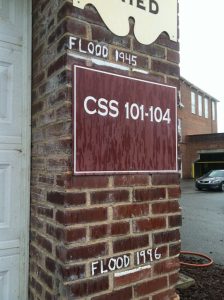How does our History Register?

 When John Newlin and his sons started construction of the cotton mill here in Saxapahaw in 1844, the mill used water from the Haw River to drive its machinery. The slaves that dug the millrace (the channel to direct the mill-wheel current) were freed by Newlin, along with their families, in 1850, and taken to Ohio, then a “Free State.” The Saxapahaw Mill operated for almost 150 years until Dixie Yarns, owners from 1978 to 1995, closed its doors in 1994. In 1998 the Mill was added to the National Register of Historic Places.
When John Newlin and his sons started construction of the cotton mill here in Saxapahaw in 1844, the mill used water from the Haw River to drive its machinery. The slaves that dug the millrace (the channel to direct the mill-wheel current) were freed by Newlin, along with their families, in 1850, and taken to Ohio, then a “Free State.” The Saxapahaw Mill operated for almost 150 years until Dixie Yarns, owners from 1978 to 1995, closed its doors in 1994. In 1998 the Mill was added to the National Register of Historic Places.
How many of us are interested in the stories of a place and people, including our own? Freedom is an eternal lesson of power struggle and balance that we all live in cycles of our lives, and certainly in very different circumstances with different levels of challenge and opportunity. Our roots are this tree of humanity from which we all come, and everywhere we look, when we are willing, we can gain insight from the constantly flowing river of history and memory and human life.

Last week young graduates and their teachers at our neighboring Hawbridge and other local schools shared with us the excitement of cycles ending and beginning, accomplishments, growth both in personal development and a broadening knowledge of the world and all there is to learn. This native soil is a part of what grounds them, what makes them up in unique ways, as the food we eat and grow makes us the mix of matter that we are. (Thank you, gardeners and farmers, for your vital part!)
The stories of our lives matter. It seems to me true that as we live longer, we become more alert and interested in the long trails and threads of stories that our elders have told and can tell us. Our own memories may come back to us, illuminating the glittering sparks of memories that connect us. Every age, every mind contributes to our collective story.
I’d never heard of Africatown, near Mobile, Alabama, until recently. This story was introduced to me by way of the release of the late great Zora Neale Hurston’s transcript called Barracoon: The Story of the Last “Black Cargo. The transcript relays the story of a man, then 86, and his memories of coming on what was the last slave ship from Africa to the Alabama coast, where he and the ships-full before them were unloaded, bought and sold, and therefore settled. The year was 1860, and the slave trade had been illegal for more than 50 years. Still, Oluale Kossula — also known by the slave name of Cudjo Lewis — had been captured on the African coast, by African warriors, and sold to traders who perpetuated the profit and enslavement. Hurston’s transcript/manuscript was written almost 90 years ago. Some publishers were interested, but only if she rewrote it without the dialect, which she declined to do. Anthropologists, linguists, families. people who are steeped in the way-of-the-word to guide our history, daily life, and memories of the past, present, and future (as one) appreciate all that our language reveals and offers. Without the dialect, we lose vital elements of the human being whose story, both individual and collective, it is.
Lewis was enslaved for five and a half years, and after the Civil War, he and other survivors of the ship helped to found Africatown, a community of their own with a receding history.
This story may seem far removed from the Rivermill in our midst, but, as one reviewer wrote about Hurston’s Barracoon: “The reader who commits to that vernacular is richly rewarded for persistence.” When we villagers, community members, think about the persistent history of what came before us, what always flows through and past us, artifacts and stories appear before us all the time. They are as important as the air we breathe, the ground we walk, the water we drink and paddle through. The soil which enriches and gives us the plants we cherish as we eat them and enjoy their beauty is the same chemical mix that makes us up — that our survival depends upon. The quality of our experience also depends upon our dreams and visions, what inspires us. The disciplines of life and what prepares us to move from one stage of life to another are important too. At least equally important, I believe, is what moves us, teaches us, inspires us. As Andrew Hartman, professor of History puts it, “…We should allow students to revel a bit in the things that inspire them.” That may be the most fertile ground of all.
This General Store’s tenth anniversary, next month, is another profound reminder of the collective energy, time, and persistent commitment that is the creation of this place, and this Village, in its current form. For those of us who are part of it, this persistent commitment is its own reward, as we learn to appreciate daily creation in deeper and new ways. Stories improve us, and the sharing of our lifetimes of stories in any moment brings the elements that nurture a person, a place, a community to light, to life. Hank Sanders, a high school student in a Portland, Oregon Culinary Arts class put it this way: “Eat one meal at the same table and change your perspective.”
